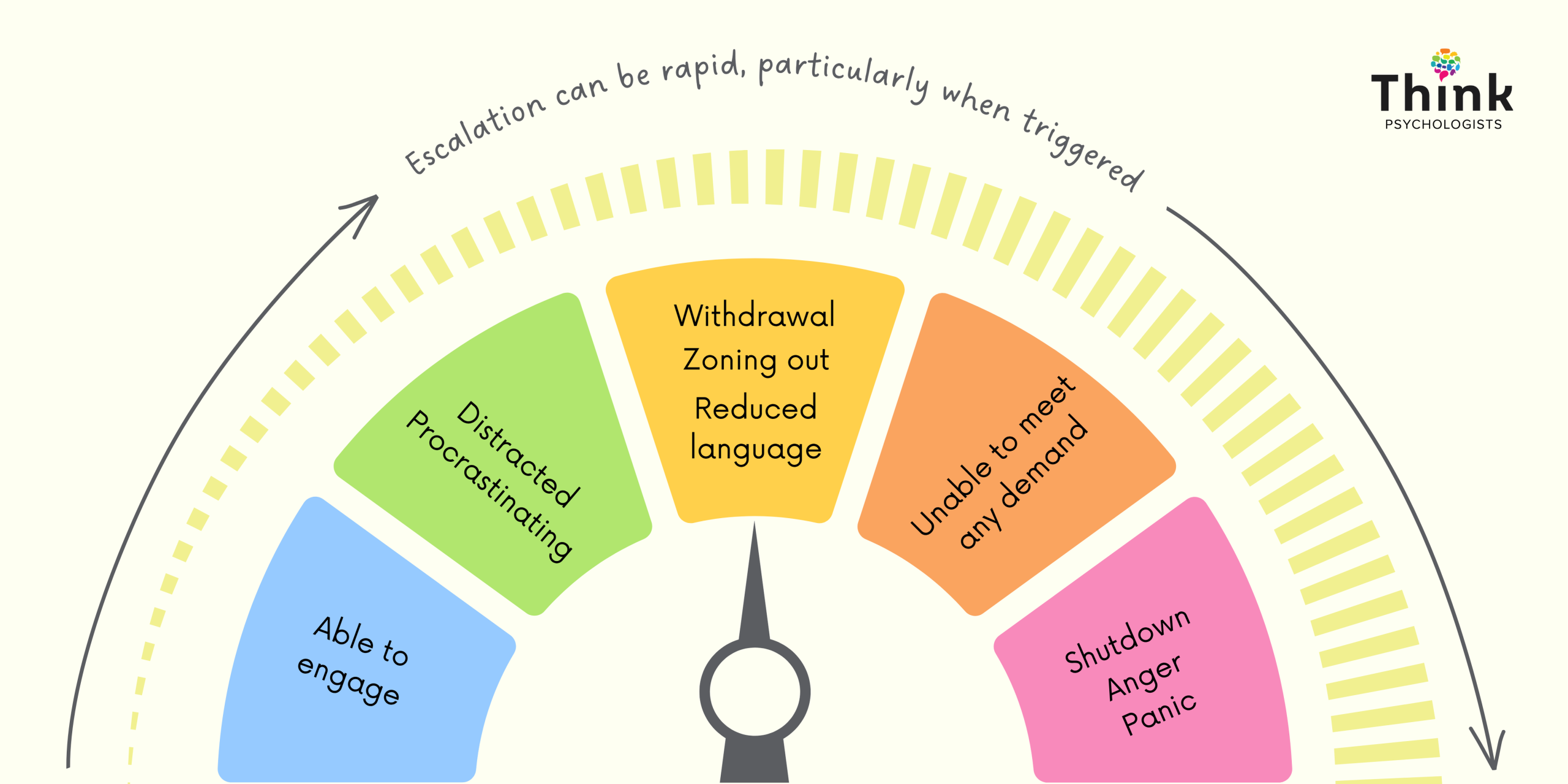How low-demand language can support children with PDA (and sensitive kids too)
Co-authored by Psychologist Dr Nicole Carvill, and Speech Pathologist Caitlin Jolly

If you’re parenting a child with a PDA profile, you’ve probably noticed that even the smallest request can spark anxiety at times.
“Put your shoes on.”
“Can you get in the car?”
“Let’s go say hi.”
Children with PDA can often experience everyday demands as threats to their sense of safety. And when they’re feeling overwhelmed, anxious or out of control, even kind, well-meaning words can feel like too much.
That’s where low-demand language comes in.
This gentle and flexible way of communicating can help reduce stress, support regulation, and rebuild connection, without compromising needs or routines.
This article explores the insights of leading voices in child wellbeing, Dr Nicole Carvill, Director and Psychologist at Think, and Caitlin Jolly, Speech Pathologist and Director of Interact Speech Pathology. It takes a look at what low-demand language looks like, why it works, and how it can be used effectively at home, in therapy or at school.
What is a demand?
Before we talk about changing language, it’s important to understand what counts as a demand – and how they show up in unexpected ways.
Nicole explains that demands go far beyond the obvious. Yes, “clean your room” and “finish your homework” are demands. But so are:
- Greeting a friend on the street
- Turning off a device
- Saying thank you
- Holding hands to cross the road
- Making eye contact
- Asking, “How was your day?”
Even internal signals like hunger or needing the toilet can feel like a demand to a PDA child.
Caitlin explains it this way: “All language is demanding because it requires a response. For PDA kids, even a compliment or a friendly hello can trigger an anxiety response. You might see responses from your child like fight, flight, freeze or fawn – all signs of stress, not defiance”.
That’s why it’s so important to consider not just what you’re asking, but how you’re asking it.s a big part of why I do what I do today.”
Understanding the PDA scale of distress
Sometimes even the smallest requests, like brushing teeth, packing a bag, or saying goodbye, can feel too much. When a child’s nervous system is already under strain, those everyday moments can quickly lead to shutdown or overwhelm.
That’s where low-demand language can make a difference. By reducing pressure and offering more emotional safety, we can help ease distress and support regulation.
If you’d like to understand more about how anxiety builds in PDA children and why certain behaviours escalate so quickly, our PDA guide for parents and carers explores the underlying drivers in more depth, including the PDA scale of distress.
© 2025 Think Psychologists: The Distress Dial™. All rights reserved.
The famous elastic band analogy
Think of your child’s emotional capacity like an elastic band. If that band is already stretched tight, due to tiredness, hunger, sensory overwhelm, or accumulated stress, they’ll have little capacity to cope with even the lightest demands.
When the band is loose, your child may have more flexibility to handle what’s being asked. But when the band is already stretched tight, even “Put on your shoes” can cause it to snap.
Want to keep the elastic band loose? Soften your language. Speak less. Let things sit. And reduce the number of questions you ask, especially in high-stress moments.
If you find mornings are particularly difficult to manage, take a look at our guide on navigating PDA and School Avoidance.
How does low-demand language help?
Low-demand language is a communication approach that avoids placing pressure on a child to comply. It’s not about giving in or being permissive, it’s about creating emotional safety.
Nicole shares that this often starts with raising awareness. “Parents are surprised by how many hidden demands exist. We use our Daily Demands Checklist to help families spot these. That alone can be a lightbulb moment.”
It’s not just what you say, but also:
Your tone
Your pace
Your body language (even a shrug or raised eyebrow can be felt as pressure)

Directive vs declarative: why it matters
Most of us default to directive language, which is a completely normal approach:
- “Put on your hat.”
- “It’s time to do your homework.”
- “Say goodbye.”
But for PDA children, this language can provoke an immediate shutdown. It removes choice and control, and that’s where anxiety spikes.
Instead, try declarative language. Caitlin explains, “We want to reframe our words so they sound more like a comment than a command. It gives the child space to socially observe and decide if and how they respond.”
Examples of declarative swaps:
✅ “Your shoes are by the door.”
✅ “Looks like it’s nearly time to go.”
✅ “I’m heading to the car now.”
This small change reduces perceived pressure and gives your child a sense of control and autonomy.
Why choice questions don’t always help
Most parenting advice books will encourage you to offer a choice:
- “Would you like the red shirt or the blue one?”
- “Do you want to do homework now or after lunch?”
But Caitlin notes that this can still be perceived as high demand, “We want to avoid forced-choice questions. Even picking between two options can feel like pressure. Instead, use language like ‘I’m wondering,’ ‘I noticed,’ or ‘Let’s see.’”
Try these phrases:
✅ “I noticed you like that shirt – it’s clean and on the bed.”
✅ “I’m wondering if we’ll have time for a game after lunch.”
✅ “I’ll be at the table with your book. It’s fun to read books together.”
These approaches create room for connection without expectation.
What about when safety is a factor?
There are times when a child’s safety needs to come first, like wearing a seatbelt, crossing a road, or stopping dangerous behaviour.
In these moments, the priority is keeping your child safe. But you can still use a calm tone, minimal language, and gentle presence to reduce additional stress.
Instead of saying:
🟠 “Put your seatbelt on”
Try:
✅ “Let me help you with your seatbelt.”
✅ “We can head to the park when everyone’s clicked in.”
✅ [Sit quietly next to them, holding the buckle]
It’s not about removing all the structure. It’s about delivering necessary information in a way that feels less threatening, and supporting your child to feel safe and seen at the same time.
What if nothing seems to work?
It’s normal to feel like you’re trying everything, and still facing pushback. That doesn’t mean you’re doing it wrong.
Both Nicole and Caitlin agree: it’s not about perfection. It’s about progress.
Nicole often reminds families, “The only failed trial is the one that never happens.” Behaviour change takes time, and what works one day might not work the next.
Caitlin adds: “Start small. Put phrases on the fridge. Give yourself permission to have hard days. Notice the moments of connection – because those are wins.”
And if all you do is soften your tone and say less today? That’s enough.
How to start using low-demand language
These shifts in language aren’t just helpful for children with a PDA profile – they can support any child (or adult) who feels anxious, overwhelmed or sensitive to pressure. You might even find they create more calm across the whole household.
Here are a few simple ideas to try this week:
✅ Swap questions for comments. Think “I’m heading outside now”, instead of “Do you want to come outside?”
✅ Reduce verbal instructions, use friendly gestures where you can – be mindful not to use gestures as a demand (eg. a pointed finger or stare)
✅ Slow down your pace, lower your tone
✅ Use humour and play when your child is open to it
✅ Let some tasks go for now to reduce overall pressure
If you’re not sure where to begin, our Daily Demands Checklist Bundle can help you spot both obvious and hidden demands that might be adding pressure throughout the day.
You’re doing better than you think
If you’re here reading this, it means you care. You’re already taking the first step by being curious and open to something new.
With time, small language shifts can lead to big changes in trust, communication and regulation. You don’t need to do it perfectly. You just need to keep showing up, and we’re here to support you.
Our Parent Support Program is available for anyone seeking one-off or occasional support.
Further reading
🌐 Articles
- PDA: A Guide for Parents and Carers
- Navigating PDA and School Avoidance
- Autism Awareness Centre – Low Demand Parenting
👆 Downloads
- Daily Demands Checklist Bundle: A practical download designed to help parents, educators, and professionals better understand the wide range of everyday demands children face—both obvious and hidden. The checklist highlights how demands show up across home, school, social, and transition times, offering a clearer picture of what might be contributing to a child’s overwhelm or distress.
📖 Books
- Declarative Language Handbook by Linda K. Murphy
- Low-Demand Parenting by Amanda Diekman
🎧 Webinars
- PDA Aware Preschools – coming soon!
An insightful webinar designed to help educators and parents understand and support PDA in preschool settings. Sign up to our newsletter to get access when it’s live.

Dr Nicole Carvill is a respected child psychologist, presenter, researcher and PhD graduate who specialises in supporting neurodivergent children and their families. As the founder of Think Psychologists, she brings warmth, insight and a strong commitment to evidence-informed care. Nicole regularly presents to parents, educators and clinicians on topics including emotional regulation, inclusive education and trauma-informed practice.
Disclaimer:
The information provided in this blog is for general educational and informational purposes only and is not intended as a substitute for professional advice, diagnosis, or treatment. Every child and situation is unique. If you have concerns about your child’s mental health, behaviour, or wellbeing, please seek advice from our team or a qualified health professional. Engaging with this content does not replace personalised support from a healthcare professional.

